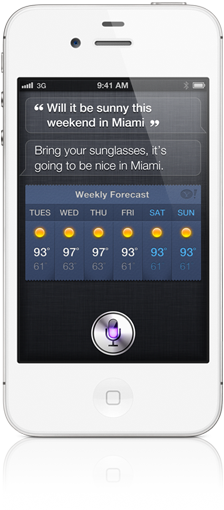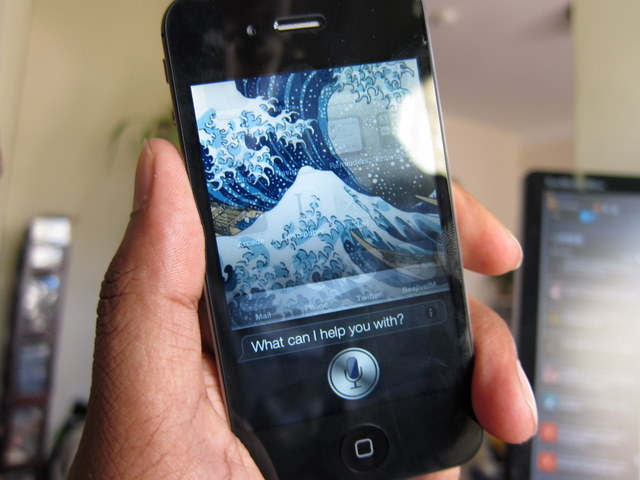Software: These boots were made for iOS5
 I was already a big fan of Apple’s latest mobile operating system, iOS 5, on the iPhone 4, but thanks to the added horsepower on the 4S, the new OS practically screams. Simple tasks now seem effortless, like moving between apps, launching games and dealing with the new notifications.
I was already a big fan of Apple’s latest mobile operating system, iOS 5, on the iPhone 4, but thanks to the added horsepower on the 4S, the new OS practically screams. Simple tasks now seem effortless, like moving between apps, launching games and dealing with the new notifications.
The upgraded notifications system in iOS 5 means you’ll never have another annoying pop-up box disrupt your workflow. Instead, notifications appear elegantly at the top of the screen. They’re collected in a notifications tray you can swipe down to access (yes, just like on Android devices).
I’ve also grown to love Apple’s new iMessage service, which serves as an iOS alternative to RIM’s popular BlackBerry Messenger. It’s faster and smarter than texting, and it doesn’t require any extra texting charges, since messages to other iOS 5 users go over the data network. iMessage is fully integrated into the existing texting app, so most users won’t even realize when they’re sending a free iMessage.
Dealing with the iPhone’s camera is also less cumbersome in iOS 5. You can now access the camera app quickly by double-clicking on the home button from the iPhone’s lock screen, and the volume up button can finally be used as a shutter button. Apple has also added some basic editing capabilities to its photo app, including red-eye removal, cropping, rotating and auto-enhancing. You’ll still need additional apps to do more advanced editing, but it’s nice to have some basic tools built-in.
Apple built iOS 5 with support for iCloud in mind. iCloud is Apple’s new free cloud storage service that aims to make working across Apple devices seamless. For example, it instantly synchronizes your work from Apple’s iWork office applications, Pages, Numbers and Keynote. You could start a document on your iPad, and easily continue working on it from your iPhone or Mac desktop since it’ll be automatically synchronized.
Perhaps the most interesting feature iCloud brings to the iPhone is Photo Stream, which automatically uploads your pictures to iCloud, making them easily accessible from other iOS devices and Mac computers. Photo Stream saves up to 1,000 photos for 30 days, and it removes the headache of manually synchronizing your iPhone photos across multiple devices. You’ll likely never lose another iPhone photo again.
iCloud also replaces MobileMe, giving you access to me.com email addresses, as well as the Find My iPhone app, which lets you locate, lock, and remotely wipe your iPhone if you lose it.
The iPhone 4S offers the best iOS experience yet, though at this point the operating system’s age is beginning to show. Compared to Android’s widgets and Windows Mobile’s live tiles, the iOS home screen still looks like a static wall of icons, rather than something alive and dynamic. Some improvements to the multitasking interface would have been welcome, as it still feels like you’re coming to a full workflow stop when switching between apps.
Siri: Or, my affair with a virtual assistant
 Exclusive to the iPhone 4S is the much-hyped virtual assistant Siri, which replaces the iPhone’s clunky voice commands. Siri does everything that the previous voice commands did, like calling a specific contact, but it’s much smarter and, most importantly, it has a personality. Instead of commanding your phone like it’s just a machine, Siri allows you to have a conversation with your phone using natural language.
Exclusive to the iPhone 4S is the much-hyped virtual assistant Siri, which replaces the iPhone’s clunky voice commands. Siri does everything that the previous voice commands did, like calling a specific contact, but it’s much smarter and, most importantly, it has a personality. Instead of commanding your phone like it’s just a machine, Siri allows you to have a conversation with your phone using natural language.
That makes Siri an important leap in the way we communicate with our machines. While it’s not a true AI, Siri is smart enough to surprise you at times. And as it gets access to more data, Siri will only evolve. After a few days of using it, Siri has already fundamentally changed the way I interact with my phone. I’m beginning to wonder if I’ll even consider future phones that don’t offer something similar.
You can access Siri by holding down the iPhone 4S’s home button, or by simply holding the phone up to your ear. Once activated, you can ask Siri to do things like make an appointment for you, send a text message, or check local restaurant listings. Siri has access to all of your phone’s resources, so it won’t double-book you if you’ve listed an event in your calendar, and it will ask to make sure it’s sending an email to the right person, if they have a common name.
Thanks to Siri, iPhone users who find phone calls passe will finally have a reason to talk to their phones again. And as my colleague Dean Takahashi points out, kids will also get a kick out of it. (Imagine the expectations kids growing up with Siri will have when it comes to interacting with technology.)
Siri certainly isn’t perfect yet. It only has access to information from a few sources, like Yelp, which provides local business review data, and Wolfram Alpha, which makes Siri a talking calculator and trivia buff. It still makes transcription errors if you mumble, or are in a noisy environment. Siri also requires network access to function, which makes it practically useless in areas with low cellular reception. But when it works, it’s magic.
For example, I was curious about Oscar winners over the last decade, so I asked Siri, “What won the Oscar for best picture in 2001?” Siri replied back with a detailed sheet of information about “Gladiator”, which included other awards the film was nominated for. I also recently tried to book a lunch meeting using Siri, and it wisely told me I was busy at the time I was requesting. Just like a real personal assistant, Siri is often more organized than you are.
In addition to virtual assistant capabilities, Siri also brings dictation to iOS, a feature Android phones have been sporting for some time. In most text fields, you can click the microphone button in the iPhone’s keyboard and simply speak aloud to have your words transcribed. This makes replying to text messages, or dealing with on-going instant messaging conversations, much easier than pecking away at the iPhone’s software keyboard.
Without Siri, the iPhone 4S is basically just a souped-up iPhone 4. With Siri, the 4S becomes something much more than just a phone — it becomes a gateway to a future where talking to our computers will be as commonplace as talking to our loved ones.

